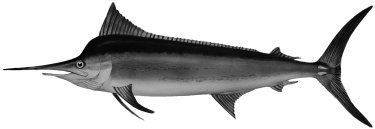
|
Relevant synonyms
Misidentification
Meristic formula
|
|
| drawing : Tuvia Kurz |
|
SHORT
DESCRIPTION
color : head and body dark blue dorsally and silvery-white ventrally. First dorsal fin dark blue or blackish; other fin dark brown. size : common 150-310 cm (max. 460 cm - ca. 700 kg). |
DISTINGUISHING CHARACTERISTICS
BIOLOGY / ECOLOGY
habitat : epipelagic oceanic. |
|
1st
MEDITERRANEAN RECORD
|

|
|
DISTRIBUTION
* Note: no other record in the Mediterranean. However, Bini (1968) mentioned a very large billfish (385 cm, 310 kg) that was caught in a tuna trap at Gallipoli, Ionian Sea, but not preserved. On the basis of the recorded sizes, it clearly belonged to the genus Makaira. |
ESTABLISHMENT SUCCESS
speculated reasons for success :
|
|
|
MODE OF
INTRODUCTION |
IMPORTANCE TO
HUMANS |
|
KEY
REFERENCES
|
 Tetrapturus indicus
Tetrapturus indicus